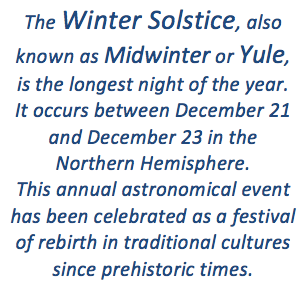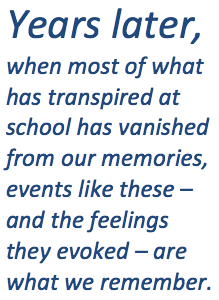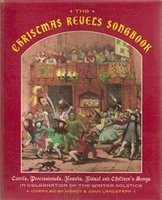Preparing a Winter Solstice Celebration For Your Students
For many people, the idea of Christmas in July is something of a spoof or a stunt – stores have sales or bars have happy hour specials, that sort of thing. When I took a brief hiatus from teaching in the late 1990s and ran the CD store at Barnes & Noble in Clearwater, on July mornings before the store opened I would sometimes play The Klezmonauts’ Oy to the World! – a raucous high-energy collection of Klezmer versions of traditional Christmas carols – to begin the day with good humor and fun.
But for many music teachers, summer time is the season to plan curriculum for the school year to come, and for years, Christmas in July to me meant: the beginning of half of each year spent planning, preparing, and executing the fall semester. In several schools I taught at, this inevitably culminated in a grand holiday performance that included all my students, usually held in the beginning of December and inevitably including anywhere from a fair amount to a veritable cornucopia of holiday-themed music and other forms of celebration.
Celebrating the Winter Solstice
When I began teaching at Blue Rock School in 1991, the school already had in place the tradition of presenting a Winter Solstice celebration each December. The event incorporated music, movement, and drama, and was eagerly anticipated by all of the children as we prepared for this special night throughout the fall. I directed four of these productions during my years at Blue Rock, and those experiences informed my attitude about the importance of this kind of event in the lives of children significantly.
 Also during those years I was introduced to the wonderful Christmas Revels: seasonal community celebrations which are performed by (combined amateur and professional) companies throughout the country. We attended several productions of Christmas Revels presented by the New York company during our time there, which I mined for ideas and inspiration for my own Winter Solstice productions at Blue Rock.
Also during those years I was introduced to the wonderful Christmas Revels: seasonal community celebrations which are performed by (combined amateur and professional) companies throughout the country. We attended several productions of Christmas Revels presented by the New York company during our time there, which I mined for ideas and inspiration for my own Winter Solstice productions at Blue Rock.
I performed in two sets of college madrigal dinner productions as well – at Scripps College (even though Scripps is a women’s college, its music program provided opportunities to all of the students at the Claremont Colleges regardless of gender) as a member of the Scripps College Chamber Choir under the direction of Michael Deane Lamkin in 1984, and then a dozen years later at the University of South Florida in the USF Chamber Choir under Robert Summer in 1996. I used ideas from all of these experiences when designing my own productions over the years.
What became very clear to me was that these performances were very important to my students, and I took my personal responsibility for providing an experience of high quality for them very seriously. Years later, when most of what has transpired at school has vanished from our memories, events like these – and the feelings they evoked – are what we remember.
The celebration of an event like the winter solstice, which has been observed since prehistoric times by nearly every culture, (religious celebrations are relatively more recent permutations of a much older tradition) is an important experience for a child to be a part of, and can provide a feeling of connection to past humanity that few other opportunities provide.
 A celebration of the solstice also can be presented as a sort of “religion-neutral” performance, in which music or other elements from various sacred traditions can be included without the event endorsing any particular religious viewpoint. This is especially important in the secular environment so many of our schools cultivate – or demand.
A celebration of the solstice also can be presented as a sort of “religion-neutral” performance, in which music or other elements from various sacred traditions can be included without the event endorsing any particular religious viewpoint. This is especially important in the secular environment so many of our schools cultivate – or demand.
Over the course of my teaching career I produced December school performances with a Winter Solstice theme for every age group K – 12.
Establishing a Tradition
Years of preparing these productions in several school environments led to my following a kind of format, in which certain elements were repeated each year, whereas other elements (most) would vary from year to year. Establishing expectations that certain songs or ceremonial elements will be part of the performance from year to year will over time, engender a tradition which becomes a part of your music program’s community – and ultimately that of your school.
Exactly what elements you choose to repeat each year will vary according to the circumstances of your school and your student population. These are the elements which I repeated each year, and which became traditions for my programs:
- a Processional (Personent Hodie)
- The Boar’s Head Carol
- a Wassail Carol
- the Mummer’s Play
- a Ritual Dance
- The Shortest Day (poem)
- a Recessional
Articles on the elements listed above will follow this one and will be linked from this list as I post them. I have already written here on Off The Podium about The Boar’s Head Carol, finest of carols, and hands-down favorite of most of my students over the years – don’t miss the opportunity to share this one with your students!
I was not always able to use every element listed above, every year – but the inclusion of as many as possible helped each Winter Solstice celebration feel complete.
Resources
My Winter Solstice programs primarily featured traditional music. There are a lot of reasons for this, one of the strongest being the fact that a vast amount of beautiful music has been written for Advent and Christmas over the last several hundred years. I feel it is one of the responsibilities of a school music teacher to introduce her students to our historical musical heritage, which more and more is vanishing from our popular, secular culture. If we don’t introduce our students to the traditional and classical repertoires, who will?
One of the fine aspects of a Winter Solstice performance is that it can easily incorporate music from more than one tradition – over the years, my programs included not only sacred Christian music, but also music celebrating Hanukkah and Kwanzaa. In addition, I sought out songs that evoked or described the winter season that were free of any religious context or association, yet were of high quality musically and not associated with popular culture.
In a secular school environment, despite the fact that sacred music is a vital part of western culture, teachers can face a lot of opposition when bringing music with religious texts. For this reason there were Christmas carols I never brought to my school choirs, such as O Little Town of Bethlehem or Joy to the World. However, I found that one way around this dilemma that allowed me to introduce my students to many great selections from the sacred repertoire was to simply teach the songs in their original languages. In this way, I not only gave my students the opportunity to sing such gems as Corde natus ex parentis (Of the father’s love begotten), but also achieved the curricular goal of helping them become fluent in singing other languages.
There are a lot of resources available to teachers in search of fine material for a Winter Solstice performance – many more now than when I began directing these productions in the days before internet. I searched for the best music I could find for these programs, wherever I could find it, and often found myself making the arrangements my students would perform myself. Two books in particular, however, I found myself returning to again and again over the years – veritable treasure troves of seasonal material.
 The Oxford Book of Carols was first published in 1928 by Oxford University Press. It was edited by Percy Dearmer, Martin Shaw and Ralph Vaughan Williams, and when I bought the copy I still use in 1986, it was the most authoritative collection of traditional carols I could find. Many, many of the carols I taught my choirs over the years can be found in this book, and it is a terrific place to start for source material when making arrangements of traditional carols. The New Oxford Book of Carols, edited by Hugh Keyte and Andrew Parrott, was published in 1992 and presumably represents a more contemporary attitude on the part of its anthologists – this edition may be preferred by teachers today when choosing a resource for the purposes for which I used the original volume.
The Oxford Book of Carols was first published in 1928 by Oxford University Press. It was edited by Percy Dearmer, Martin Shaw and Ralph Vaughan Williams, and when I bought the copy I still use in 1986, it was the most authoritative collection of traditional carols I could find. Many, many of the carols I taught my choirs over the years can be found in this book, and it is a terrific place to start for source material when making arrangements of traditional carols. The New Oxford Book of Carols, edited by Hugh Keyte and Andrew Parrott, was published in 1992 and presumably represents a more contemporary attitude on the part of its anthologists – this edition may be preferred by teachers today when choosing a resource for the purposes for which I used the original volume.
 The Christmas Revels Songbook – Carols, Processionals, Rounds, Ritual and Children’s Songs by John Longstaff and Nancy Langstaff was first published in 1985. John Longstaff (1920 – 2005) was a baritone soloist and figure in the 20th century early music revival who attended Curtis Institute of Music and Juilliard. He founded the Christmas Revels in 1957, and this excellent book brings together many staples from the first three decades of Revels productions. My copy, which was given to me by the family of a student for Christmas in 1991, is dogeared and crowded with notes. There are many great arrangements in this volume, as well as hard to find jewels you won’t come across elsewhere.
The Christmas Revels Songbook – Carols, Processionals, Rounds, Ritual and Children’s Songs by John Longstaff and Nancy Langstaff was first published in 1985. John Longstaff (1920 – 2005) was a baritone soloist and figure in the 20th century early music revival who attended Curtis Institute of Music and Juilliard. He founded the Christmas Revels in 1957, and this excellent book brings together many staples from the first three decades of Revels productions. My copy, which was given to me by the family of a student for Christmas in 1991, is dogeared and crowded with notes. There are many great arrangements in this volume, as well as hard to find jewels you won’t come across elsewhere.
* * *
Preparing a School Winter Solstice Performance:
Christmas in July
In Comes I: The Student Mummer’s Play
We Come To Show Activity: Producing a Student Mummer’s Play
Fieldston Outdoors Mummer’s Play




[…] Christmas in July […]
[…] Christmas in July […]
[…] Christmas in July <– START HERE […]
[…] Christmas in July <– START HERE […]
[…] Christmas in July <– START HERE […]
[…] Christmas in July <– START HERE […]
[…] Christmas in July <– START HERE […]
[…] Christmas in July <– START HERE […]
[…] Christmas in July <– START HERE […]
[…] an article on The Boar’s Head Carol. But the series really started rolling this summer with Christmas in July. At this point it includes eleven articles including quite extensive materials for presenting a […]
[…] musical, etc.) For instance, in several schools I taught at, every December my program presented a Winter Solstice celebration, and I never taught at a school where I did not produce a spring concert of one kind or […]